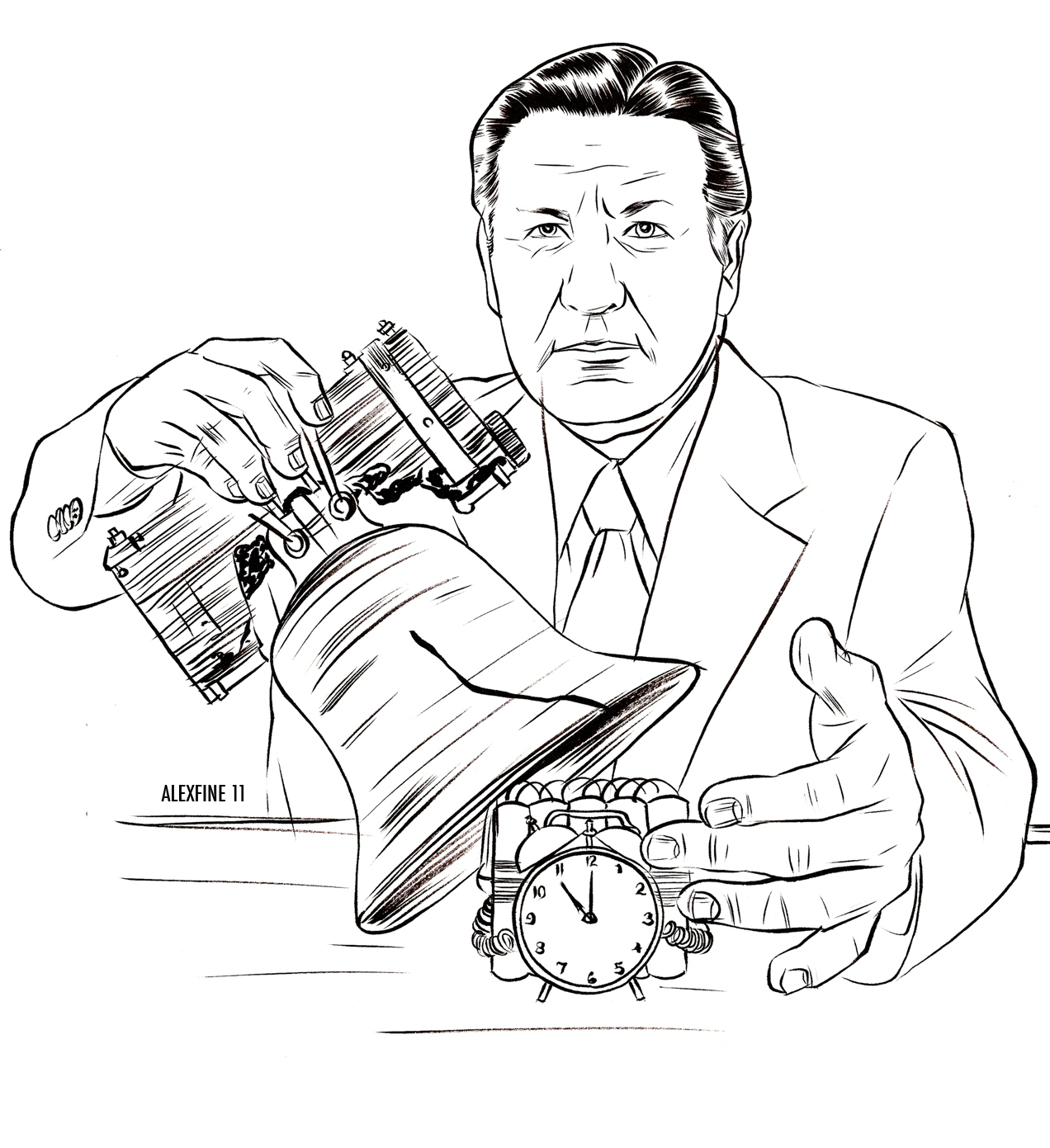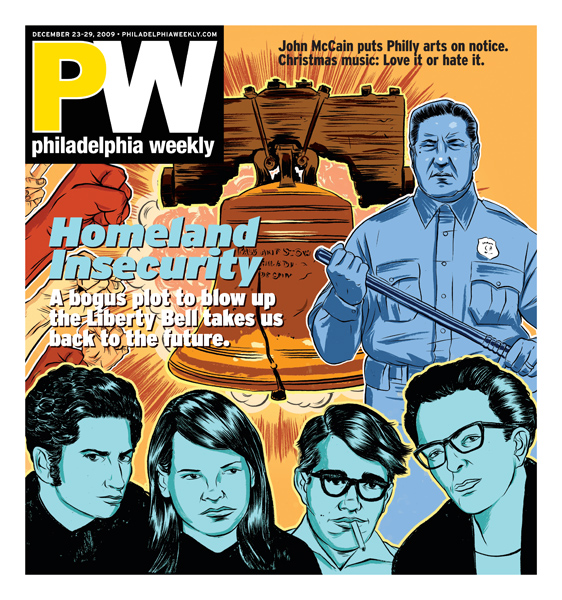
INQUIRER: The crowd surrounding the Frank L. Rizzo statue Saturday afternoon seemed to be in a time warp, as the former Philadelphia mayor’s entourage and admirers came out to pay their respects. The Quaker City String Band played as dignitaries arrived on foot and in cars, some following the motorcade that came down Broad Street from Holy Sepulchre Cemetery in Cheltenham to the Municipal Services Building, across from City Hall. Saturday marked 20 years since Rizzo died of a heart attack while campaigning for a third term as mayor, a job he had held from 1972 to 1980. Even in death, the former police commissioner, who would have been 90, has continued to inspire many Philadelphians. Those who knew him and worked for and with him remain loyal to this day. “I loved him,” said Jody DellaBarba, Rizzo’s secretary and aide during his last campaign, handing out old memorial cards. MORE
RELATED: Lynne Abraham read from the book The Sayings of Chairman Frank: Or, I Never Saw My Mother Naked. Rizzo, known for a blunt persona that rallied some and riled others, often used violent imagery in his statements. Of his challenge from political rival Tom Foglietta, he said: “Listen, Foglietta couldn’t beat me in South Philly if I gave him the voting machines tonight. Councilman Foglietta, if you had any sense, you could take a reading of the crowd here today and go home and slit your throat,” Abraham read, drawing much laughter. MORE
TIME: Philadelphia’s tough-talking Democratic mayor, Frank Rizzo, has long been as hard on syntax as he is on the “vermin” he blames for his city’s problems with crime and decline. During his campaign for a second four-year term in 1975, for instance, the blustery former police chief offered Philadelphians a typically unpunctuated promise: “Just wait after November you’ll have a front row seat because I’m going to make Attila the Hun look like a f*ggot.” MORE
FRANK RIZZO: “I like art. It was us Italians who started most of it.”
RELATED: In the spring of 1969, four activists from the Philadelphia chapter of the Students For A Democratic Society (SDS) were arrested for plotting to blow up the Liberty Bell after the police found bomb-making materials in the refrigerator of their West Philly apartment. According to the police, the planned destruction of the Liberty Bell was part of a larger plot hatched by a network of student radicals to destroy  national landmarks across the country. The shocking news spread quickly when footage of the police search of the apartment — captured by a KYW film crew invited by police to document the raid — and the ensuing arrests made the evening news. The Daily News trumpeted news of the plot in two separate cover stories with the blaring headlines: COLLEGE REBELS HELD AS RAIDERS FIND ‘MAKINGS OF BOMB’ and REBEL STUDENT PLOT TO BLOW UP PHILA. HISTORICAL SHRINES REVEALED BY POLICE. Once again, a potentially tragic incident of domestic terrorism was narrowly averted, it seemed, thanks to the aggressive due diligence of the Philadelphia Police Department and its take-no-bull commissioner Frank Rizzo. There was just one problem: There was no plot to blow up the Liberty Bell and there were no bomb-making materials, aside from what the police brought with them. But for the two long years the case kicked around the courts — long enough to put the SDS out of business in Philadelphia — none of that really mattered.
national landmarks across the country. The shocking news spread quickly when footage of the police search of the apartment — captured by a KYW film crew invited by police to document the raid — and the ensuing arrests made the evening news. The Daily News trumpeted news of the plot in two separate cover stories with the blaring headlines: COLLEGE REBELS HELD AS RAIDERS FIND ‘MAKINGS OF BOMB’ and REBEL STUDENT PLOT TO BLOW UP PHILA. HISTORICAL SHRINES REVEALED BY POLICE. Once again, a potentially tragic incident of domestic terrorism was narrowly averted, it seemed, thanks to the aggressive due diligence of the Philadelphia Police Department and its take-no-bull commissioner Frank Rizzo. There was just one problem: There was no plot to blow up the Liberty Bell and there were no bomb-making materials, aside from what the police brought with them. But for the two long years the case kicked around the courts — long enough to put the SDS out of business in Philadelphia — none of that really mattered.
Forty years later, Rizzo and just about everyone on the police and prosecution side of the case are dead and buried. But all four of the accused SDS activists — Steve Fraser, Richard Borghmann, Jane “Muffin” Friedman and Paul Milkman — continue to insist there never was a plot to blow up the Liberty Bell, that the Philadelphia SDS was loudly and proudly avowedly non-violent, and the cops planted the bomb-making material to discredit their politics and scare off potential sympathizers. The judge overseeing the case seemed inclined to agree and eventually threw the case out after two years of pre-trial hearings. But by then it was too late, the Philadelphia SDS, having been successfully tarred as a dangerous terrorist organization, was dead in the water, along with their ambitious social justice agenda for improving schools, housing and job prospects for the city’s downtrodden.
“The backlash happened very quickly, by the time I got out of jail and went back to the Penn campus people were scared of me,” says Friedman, one of the four SDS members arrested that day. “When I tried to organize a rally in support of us people would back away from me when they saw me coming like I was some kind of mad bomber.” To fully understand the significance of the case, it must be placed in the wider context of Philadelphia police’s war on perceived subversives in the late ’60s — the way they systematically harassed, intimidated and brutalized ‘uppity blacks’ and white collegeboy troublemakers — under Frank Rizzo’s leadership. Rizzo routinely invented or exaggerated these threats to scare the public and amass political power, resulting in two contentious and deeply divisive terms as mayor in the 1970s. The bogus Liberty Bell Bomb Plot bust was just the latest in a series of trumped up arrests of activists by the police department’s Civil Disobedience Unit, which was created the early ’60s to protect the constitutional rights of demonstrators while keeping the peace. Upon the appointment of Rizzo to police commissioner in 1967, the CDU became an blunt instrument of surveillance, intimidation and infiltration used to neutralize political dissent. MORE
THE GOOD NEWS FLOWER HOUR: The Phantom Plot To Blow Up The Liberty Bell
